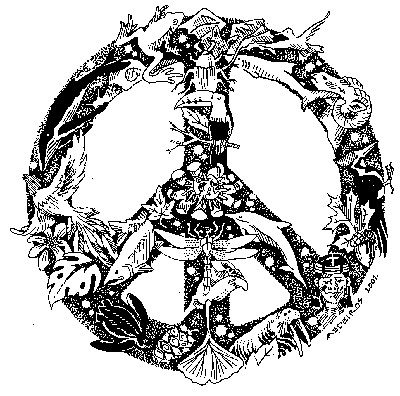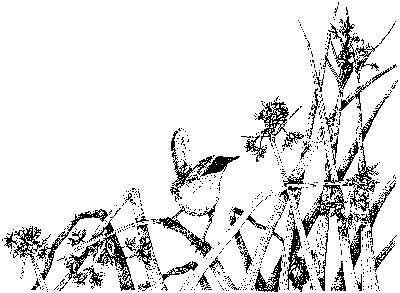


Living Lightly
![]()
Rivers of Birds, Forests of Tules: Central Valley Nature & Culture in Season
By Lillian Vallee
27. Cruising in an Ah Yah
Few will believe you if you tell them cruising went on in Stanislaus County before Graffiti Night, even before there were cars, and long before there was a county named after Estanislao, a Lakisamne (Yokuts) Indian who led an exodus of native peoples from Mission San Jose into the Central Valley interior in 1827. Nonetheless, this is a good year to remember cruising as done by the first California peoples because the rivers have re-occupied some of their historic flood plain and the sight of broad expanses of land under water makes us wonder how folks got around before levees, bridges, and roadways.
The answer is the balsa canoe, a very old form of water transportation, in use for at least three thousand years, and still used today in South America, Africa, the Mediterranean and Middle East. According to Richard Cunningham, “A balsa canoe is a hull constructed of multiple bundles of wands, canes, reeds, sedges or bark rolls lashed together and arranged in such a fashion as to create a cavity or hold. Poling or paddling are the dominant types of propulsion…” The “California standard” was a crescent-shaped canoe ranging in size from a three-bundle one-person model, six to eight feet in length, to five-bundle cruisers (reinforced with willow poles) that were over 35 feet long and weighed 1,000 pounds (dry). They featured a fishing hole and mud-lined fire pit for broiling filets, and could hold a couple of families and their “dunnage”: fishing spears, extra poles, mats for shade and baskets of acorns and dried salmon. “I label this canoe the cruiser,” writes Cunningham, “because it was launched in early summer and used by entire families on long, lazy journeys—fishing, swimming, and luxuriating in a form of recreation we now call houseboating….”
In vast Central Valley wetlands, the premier building material for boats (and many other things) was a perennial plant we call a tule, Schoenoplectus (formerly Scirpus) californicus or Schoenoplectus acutus. Many valley place names reflect the ubiquity of tules in the Spanish equivalent tulares, as in Tulare basin, once home to Tulare Lake and now to the city of Tulare or as in Tuleberg, name of the town we now know as Stockton. Early Spanish maps refer to the area we live in as el valle de los tulares, or valley of the tules, “reeds that proliferate in lagoons, bays, estuaries, and on the fringes of ponds or lakes.” Tules, or bulrushes, were omnipresent and anyone who wanted to could build a house or make a boat from them.
California Indians often burned tules to keep hunting ponds open for fishing and fowling and also to encourage new growth as the green stalks or “wands” were preferred for buoyancy and flexibility over dry tules. Harvested in late spring or early summer, mainly by women and children, versatile tules were woven (after seasoning) into sleeping mats, clothing, footwear, decoys, baskets, infant carriers and coverings for houses constructed of willow frames. The new shoots could be eaten like asparagus or boiled down for a sweetener; the cured wands could be twisted into a rope or bundled to build the so-called Yokuts cruiser or ah yah.
Imagine being a child on one of these trips. Here is Thomas Jefferson Mayfield’s recollection of floating down the Kings River to Tulare Lake in the early 1850’s:
For us children, the trip to Tulare Lake was an occasion of great excitement. We were all eyes and ears and could scarcely contain ourselves….
When we were all aboard, the boats were poled out into the stream and allowed to drift with the current. Three or four of the men stood at the sides of the raft and kept it away from snags and in the main current. In this way we floated along at two or three miles an hour.
At night the raft was moored to the bank in a quiet place and we camped on the shore. It was really one of the greatest experiences I have ever had, and certainly the greatest I had while living with the Indians. I believe that they, too, enjoyed these trips more than any of their other experiences. We traveled in style and in comfort. The river was lined with trees and wild blackberry and grape vines, and the whole trip was one beautiful scene after another.
The Northern Valley Yokuts in our area traveled the same way, drifting northward with the current on the San Joaquin River. The only difficulty may have been the long walk back, especially for small children. At the end of the float trip, the (waterlogged?) ah yah was abandoned and the party returned, hunting and fishing along the way. “The march home was not done for the sake of exercise;” comments Cunningham, “rather it was a practical matter because the thrust of the current was south to north, so a long haul uphill run in an ah yah might be considered a form of insanity.”
Get into a Yokuts cruiser this summer and imagine the beaten trails along the river covered with snowmelt; the deep drinking cottonwoods and willows along the riverbanks alive with grizzly thickets and cuckoo nests; the constellations mimicking the crackling fires as the drowsy children fall asleep, one by one, to the sounds of adult voices recounting their well worn stories. Laze northward, trail a hand in the current, take a good look at the water and land around you, and promise to make the place you live in a place worth returning to when the journey is over and you carry that sleeping child down the last mile of the trail home.
Source: M. Kat Anderson, Tending the Wild; Richard W. Cunningham, California Indian Watercraft; Thomas Jefferson Mayfield, Indian Summer; William J. Wallace, “Northern Valley Yokuts,” in Handbook of North American Indians, Volume 8.

![]()
![]()
This is an amazing book, but you can skip the first half—unless you want to lacerate your heart with more bad news. The coming decline of oil, food and fuel competing for land, emerging water shortages, rising temperatures and rising seas, natural systems under stress, our socially divided world, environmental refugees—if you’re conscious, you already know this grim stuff. I barely made it to page 120.
But then, relief! For many years Lester Brown and his World Watch Institute have been publishing State of the World, an inventory of windmills and solar panels installed, fisheries protected, children fed, immunized and educated and so on. Now the second half of his new book Plan B 2.0 brings it all together in an inspiring catalog of hope.
Imagine brainstorming with your friends how to build a sane and decent life for everyone on planet earth. You’d gather with coffee and cookies, maybe wine and cheese, big sheets of paper, magic markers, and you’d start writing: basic education for all, stabilize population, better health for all, curb HIV, end corporate farm subsidies. Okay, another page: protect and restore forests, conserve and rebuild soils, stabilize water tables, regenerate fisheries, protect plant and animal diversity, produce protein more efficiently, move lower on the food chain. Still more: hybrid cars running on wind-electricity, solar electric, geothermal, cut carbon emissions fast. One more sheet of paper: Redesign urban transport, farms in the city, reduce urban water use, make cities livable for everyone including the poor.
Tape those sheets to the wall, take a break. Then open Plan B and discover that all these wise things are already being done in one part of the world or another! Smallpox is gone, the U.S. Alaskan salmon fishery is by agreement sustainable, South Korea and Ireland are reforesting, the Danes are marketing windmills ten times more efficient than those of a few years ago, Americans are snapping up hybrid cars and waiting for the models to come on the market which can be plugged into the wall at night and be recharged on wind-generated electricity, light rail is rolling, Cuba is a leader in solar development, Dutch engineers are advising Asia, Africa and Latin America how to design cities for bicycles, and in Curitiba, Brazil slum dwellers (and everybody else) ride buses for free to public libraries which are everywhere, and for every bag of trash which the poor pick up and hand in they receive a bag of food. There are even community gardens in Stockton, California, and a Habitat for Humanity store with recycled building materials.
The new world is all around us, in bits and pieces.
Resume your brainstorming session; face the tough questions. How can we build a new economy that fosters all these good things, instead of the bad stuff we’re churning out? Again, Lester Brown points out transformations underway or being seriously proposed: impose taxes on pollution and carbon emissions instead of people’s labor, shift subsidies from oil and nuclear to clean sustainable energy, give tax breaks for super-efficient cars, require eco-labeling so consumers can vote with their wallets, foster new industries and new jobs, with opportunities for investors and workers alike.
How much would it cost to save the planet, and care for poorest among us? Brown constructs a poverty eradication budget—$68 billion annually, worldwide. And an earth restoration budget—$93 billion annually, worldwide. That’s a total of $161 billion a year. Yes, it’s a lot of money. It is also one third of the United States annual military budget, one sixth of the whole world’s annual military budget. The money is there.
But surely such a massive re-allocation of resources would take a long time? Brown recounts the history of how the U.S. economy was transformed after Pearl Harbor. Even during the Great Depression of the 1930s, U.S. automakers sold 3.1 million civilian cars a year. But Roosevelt persuaded the Congress to forbid the manufacture of civilian cars in 1942, and the entire immense productive capacity of the U.S. turned to tanks, planes, warships and merchant ships, munitions…. The Japanese, said Churchill, had awakened a sleeping giant. How was it possible? The political will was there; the people supported the transformation.
For a moment, let your imagination run. Imagine the U.S. economy turned to the production of efficient hybrid cars, windmills, solar electric panels, clean buses, light rail and high speed trains, the building of bicycle paths. Imagine ten million unemployed Americans getting jobs insulating every building in the country, producing and installing energy-efficient windows and appliances.
Imagine appealing to the idealism of young Americans to join a national service corps or a world peace corps, to learn peaceful conflict resolution under the umbrella of a new Department of Peace, complementing the Defense (it used to be called the War) Department. Congressman Dennis Kucinich has been proposing a Department of Peace for years. Rush Limbaugh recently ridiculed the idea; maybe Dennis has something? Confucius said, if you want to change the world, appeal to the best in people.
But appealing to self-interest is necessary too. Climate change is finally getting widespread attention; as the Scripps Oceanographic Institute predicted years ago, California faces long-term danger of spring floods and summer drought. Homeowners on the Atlantic Coast can no longer buy storm insurance, and two of the biggest insurance companies in the world, Swiss Re and Munich Re, are calling for urgent action against global warming. Ted Turner bought 3,569 copies of Plan B 2.0 to give to world leaders, corporate CEOs and members of Congress.
It’s high time to get to work, building a new world. In the slogan of the immense World Social Forums of the past several years,
Another world is possible.
It’s up to all of us. We are the sleeping giant.

![]()
